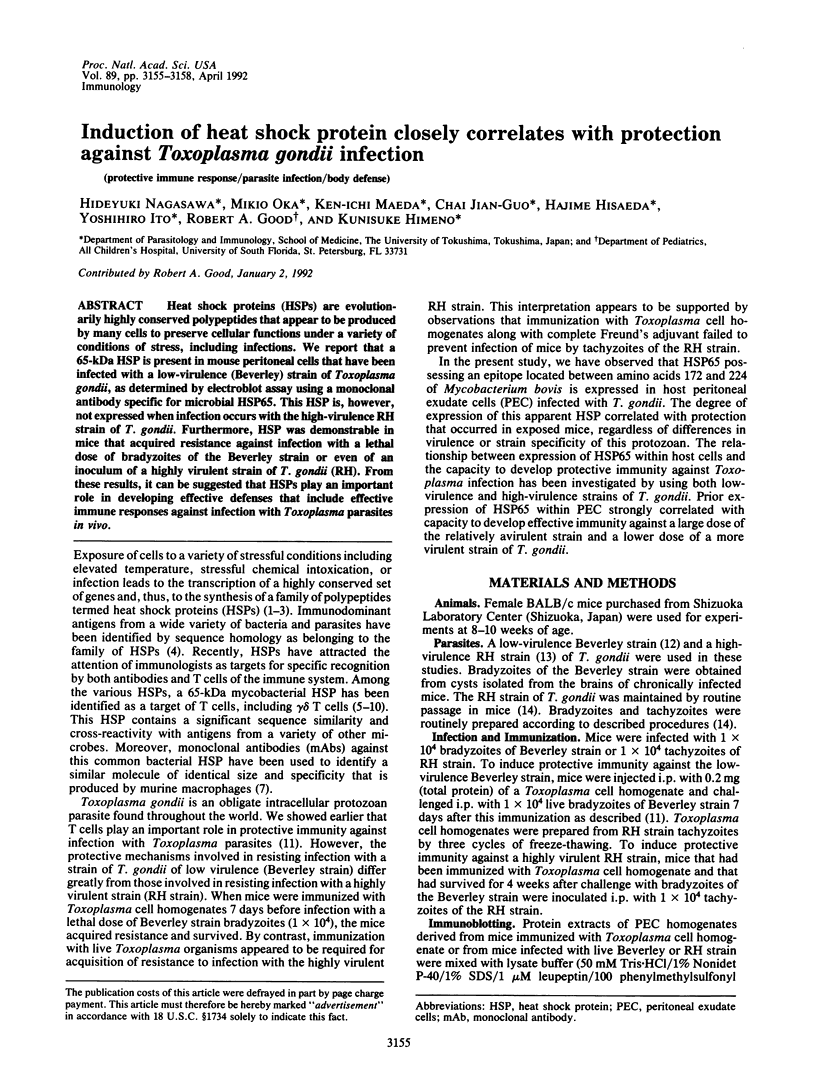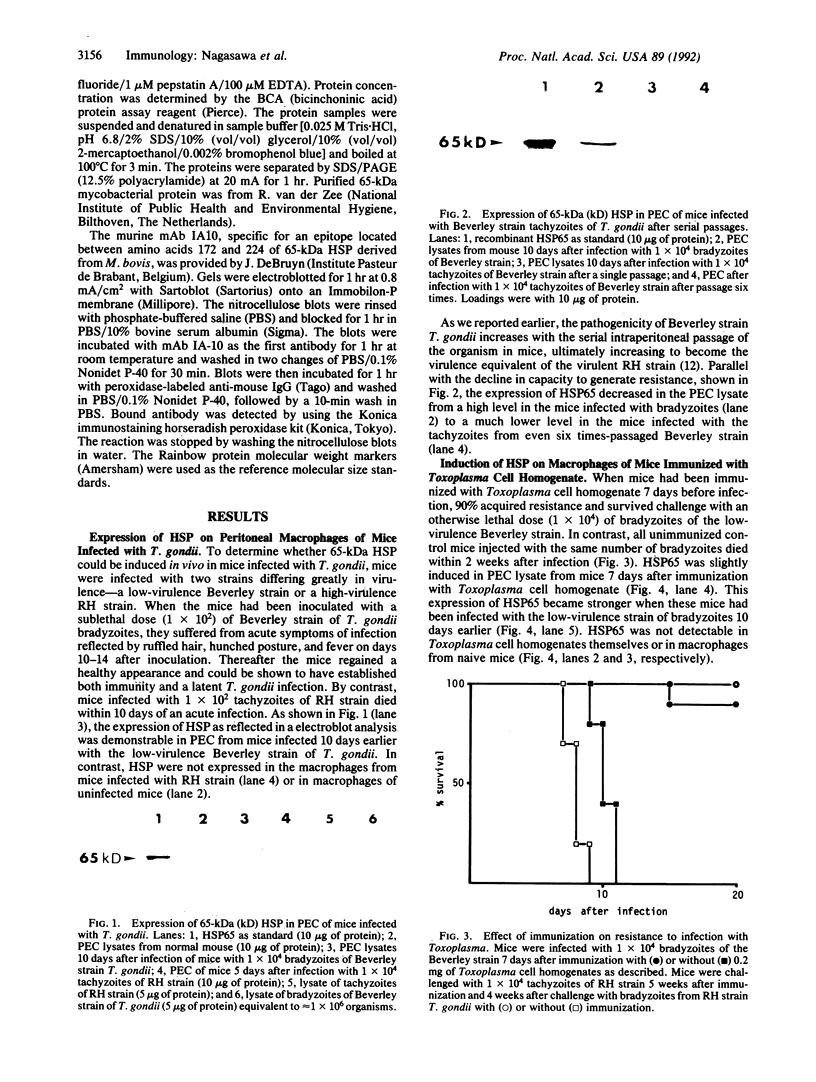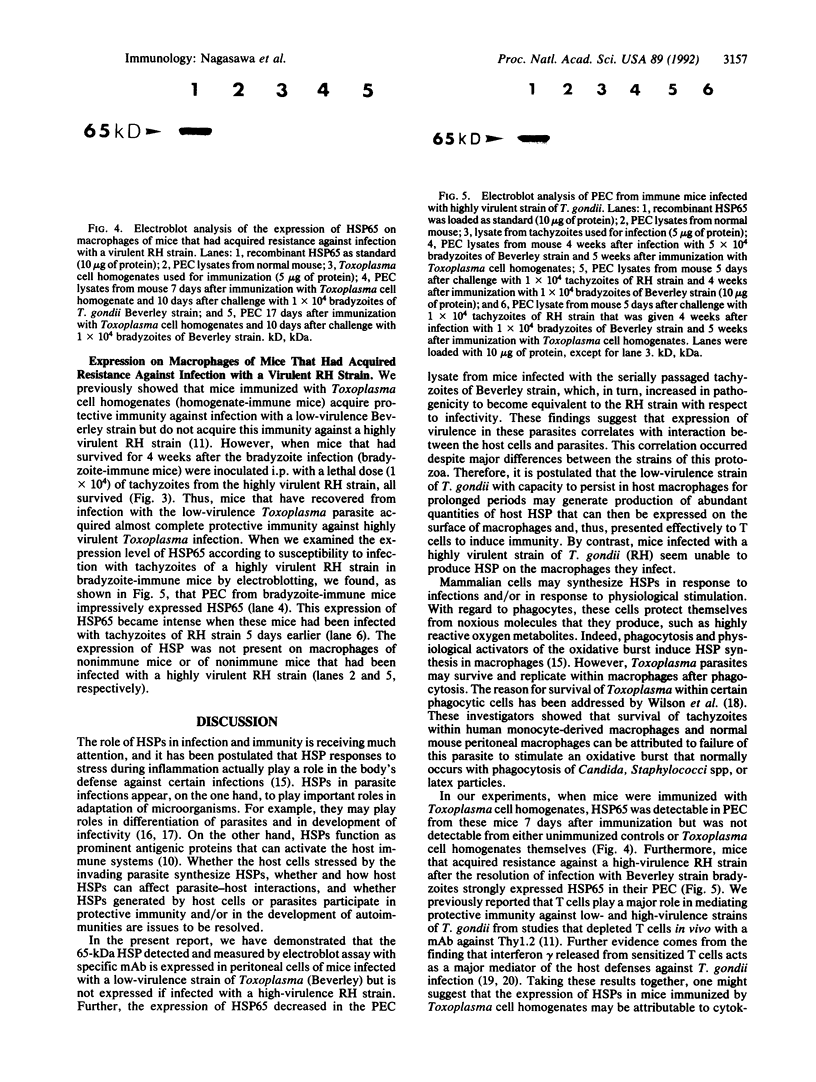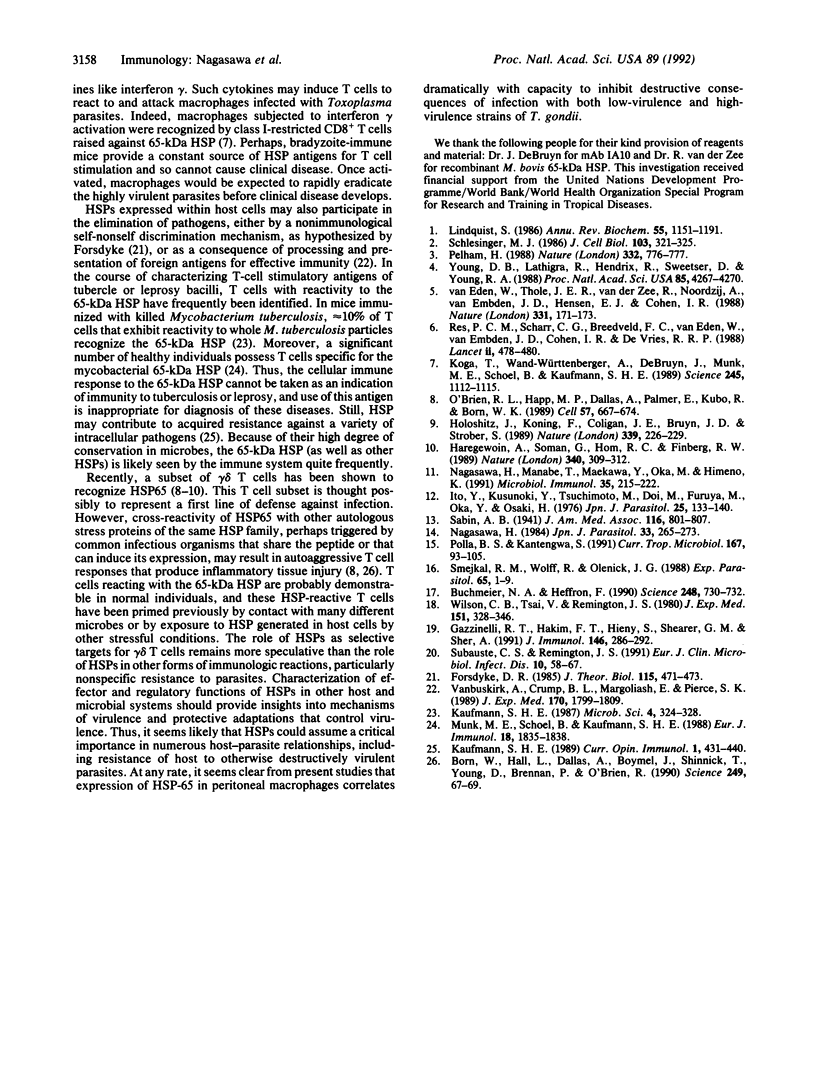Abstract
Heat shock proteins (HSPs) are evolutionarily highly conserved polypeptides that appear to be produced by many cells to preserve cellular functions under a variety of conditions of stress, including infections. We report that a 65-kDa HSP is present in mouse peritoneal cells that have been infected with a low-virulence (Beverley) strain of Toxoplasma gondii, as determined by electroblot assay using a monoclonal antibody specific for microbial HSP65. This HSP is, however, not expressed when infection occurs with the high-virulence RH strain of T. gondii. Furthermore, HSP was demonstrable in mice that acquired resistance against infection with a lethal dose of bradyzoites of the Beverley strain or even of an inoculum of a highly virulent strain of T. gondii (RH). From these results, it can be suggested that HSPs play an important role in developing effective defenses that include effective immune responses against infection with Toxoplasma parasites in vivo.
Full text
PDF



Images in this article
Selected References
These references are in PubMed. This may not be the complete list of references from this article.
- Born W., Hall L., Dallas A., Boymel J., Shinnick T., Young D., Brennan P., O'Brien R. Recognition of a peptide antigen by heat shock--reactive gamma delta T lymphocytes. Science. 1990 Jul 6;249(4964):67–69. doi: 10.1126/science.1695022. [DOI] [PubMed] [Google Scholar]
- Buchmeier N. A., Heffron F. Induction of Salmonella stress proteins upon infection of macrophages. Science. 1990 May 11;248(4956):730–732. doi: 10.1126/science.1970672. [DOI] [PubMed] [Google Scholar]
- Forsdyke D. R. Heat shock proteins defend against intracellular pathogens: a non-immunological basis for self/non-self discrimination? J Theor Biol. 1985 Aug 7;115(3):471–473. doi: 10.1016/s0022-5193(85)80205-8. [DOI] [PubMed] [Google Scholar]
- Gazzinelli R. T., Hakim F. T., Hieny S., Shearer G. M., Sher A. Synergistic role of CD4+ and CD8+ T lymphocytes in IFN-gamma production and protective immunity induced by an attenuated Toxoplasma gondii vaccine. J Immunol. 1991 Jan 1;146(1):286–292. [PubMed] [Google Scholar]
- Haregewoin A., Soman G., Hom R. C., Finberg R. W. Human gamma delta+ T cells respond to mycobacterial heat-shock protein. Nature. 1989 Jul 27;340(6231):309–312. doi: 10.1038/340309a0. [DOI] [PubMed] [Google Scholar]
- Holoshitz J., Koning F., Coligan J. E., De Bruyn J., Strober S. Isolation of CD4- CD8- mycobacteria-reactive T lymphocyte clones from rheumatoid arthritis synovial fluid. Nature. 1989 May 18;339(6221):226–229. doi: 10.1038/339226a0. [DOI] [PubMed] [Google Scholar]
- Kaufmann S. H. Immunity to bacteria and fungi. Curr Opin Immunol. 1989 Feb;1(3):431–440. doi: 10.1016/0952-7915(88)90023-4. [DOI] [PubMed] [Google Scholar]
- Kaufmann S. Towards new leprosy and tuberculosis vaccines. Microbiol Sci. 1987 Nov;4(11):324–328. [PubMed] [Google Scholar]
- Koga T., Wand-Württenberger A., DeBruyn J., Munk M. E., Schoel B., Kaufmann S. H. T cells against a bacterial heat shock protein recognize stressed macrophages. Science. 1989 Sep 8;245(4922):1112–1115. doi: 10.1126/science.2788923. [DOI] [PubMed] [Google Scholar]
- Lindquist S. The heat-shock response. Annu Rev Biochem. 1986;55:1151–1191. doi: 10.1146/annurev.bi.55.070186.005443. [DOI] [PubMed] [Google Scholar]
- Munk M. E., Schoel B., Kaufmann S. H. T cell responses of normal individuals towards recombinant protein antigens of Mycobacterium tuberculosis. Eur J Immunol. 1988 Nov;18(11):1835–1838. doi: 10.1002/eji.1830181128. [DOI] [PubMed] [Google Scholar]
- Nagasawa H., Manabe T., Maekawa Y., Oka M., Himeno K. Role of L3T4+ and Lyt-2+ T cell subsets in protective immune responses of mice against infection with a low or high virulent strain of Toxoplasma gondii. Microbiol Immunol. 1991;35(3):215–222. doi: 10.1111/j.1348-0421.1991.tb01550.x. [DOI] [PubMed] [Google Scholar]
- O'Brien R. L., Happ M. P., Dallas A., Palmer E., Kubo R., Born W. K. Stimulation of a major subset of lymphocytes expressing T cell receptor gamma delta by an antigen derived from Mycobacterium tuberculosis. Cell. 1989 May 19;57(4):667–674. doi: 10.1016/0092-8674(89)90135-9. [DOI] [PubMed] [Google Scholar]
- Pelham H. Heat-shock proteins. Coming in from the cold. Nature. 1988 Apr 28;332(6167):776–777. doi: 10.1038/332776a0. [DOI] [PubMed] [Google Scholar]
- Polla B. S., Kantengwa S. Heat shock proteins and inflammation. Curr Top Microbiol Immunol. 1991;167:93–105. doi: 10.1007/978-3-642-75875-1_6. [DOI] [PubMed] [Google Scholar]
- Res P. C., Schaar C. G., Breedveld F. C., van Eden W., van Embden J. D., Cohen I. R., de Vries R. R. Synovial fluid T cell reactivity against 65 kD heat shock protein of mycobacteria in early chronic arthritis. Lancet. 1988 Aug 27;2(8609):478–480. doi: 10.1016/s0140-6736(88)90123-7. [DOI] [PubMed] [Google Scholar]
- Schlesinger M. J. Heat shock proteins: the search for functions. J Cell Biol. 1986 Aug;103(2):321–325. doi: 10.1083/jcb.103.2.321. [DOI] [PMC free article] [PubMed] [Google Scholar]
- Smejkal R. M., Wolff R., Olenick J. G. Leishmania braziliensis panamensis: increased infectivity resulting from heat shock. Exp Parasitol. 1988 Feb;65(1):1–9. doi: 10.1016/0014-4894(88)90101-4. [DOI] [PubMed] [Google Scholar]
- Subauste C. S., Remington J. S. Role of gamma interferon in Toxoplasma gondii infection. Eur J Clin Microbiol Infect Dis. 1991 Feb;10(2):58–67. doi: 10.1007/BF01964408. [DOI] [PubMed] [Google Scholar]
- Vanbuskirk A., Crump B. L., Margoliash E., Pierce S. K. A peptide binding protein having a role in antigen presentation is a member of the HSP70 heat shock family. J Exp Med. 1989 Dec 1;170(6):1799–1809. doi: 10.1084/jem.170.6.1799. [DOI] [PMC free article] [PubMed] [Google Scholar]
- Wilson C. B., Tsai V., Remington J. S. Failure to trigger the oxidative metabolic burst by normal macrophages: possible mechanism for survival of intracellular pathogens. J Exp Med. 1980 Feb 1;151(2):328–346. doi: 10.1084/jem.151.2.328. [DOI] [PMC free article] [PubMed] [Google Scholar]
- Young D., Lathigra R., Hendrix R., Sweetser D., Young R. A. Stress proteins are immune targets in leprosy and tuberculosis. Proc Natl Acad Sci U S A. 1988 Jun;85(12):4267–4270. doi: 10.1073/pnas.85.12.4267. [DOI] [PMC free article] [PubMed] [Google Scholar]
- van Eden W., Thole J. E., van der Zee R., Noordzij A., van Embden J. D., Hensen E. J., Cohen I. R. Cloning of the mycobacterial epitope recognized by T lymphocytes in adjuvant arthritis. Nature. 1988 Jan 14;331(6152):171–173. doi: 10.1038/331171a0. [DOI] [PubMed] [Google Scholar]






